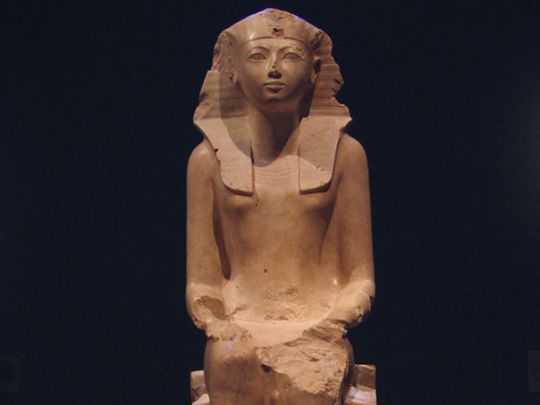
On a hot day in 1927, archeologists unearthed a scene of brutal destruction at the enormous temple complex of Deir el-Bahri, in Egypt. They found a pit that held smashed statues of a pharaoh, and the attack seemed to be vicious… and personal. The pharaoh was Hatshepsut, one of the few rare women pharaohs to rule Egypt.
Click start to play today’s Word Search and find “Hatshepsut” along with other emperors, kings and queens.
Hatshepsut was only the third woman to become pharaoh in Egypt’s 3,000 years of ancient history, according to History.com. But her reign was full of soap opera-like themes of revenge, and deceit.
According to the Smithsonian Magazine, the official journal published by the Smithsonian Institution in Washington, US, evidence of her reign from 1479 to 1458 BC did not emerge until the 19th century. This, despite the fact that her long rule had been a time of peace and prosperity – full of rich art, and ambitious building projects.
However, Hatshepsut’s questionable methods of climbing the ladder to the most powerful position in Egypt showed her darker side.
As the widowed queen of pharaoh Thutmose II, she was made regent in 1479 and ruled for her stepson Thutmose III until he came of age. What people didn’t expect, however, was for her to proclaim herself pharaoh. She is even known to have insisted on being portrayed as male, with huge muscles and a traditional false beard.
One of the theories floating around is that Hatshepsut’s elevation to pharaoh was an act of naked ambition. Some think that the desecration of her tomb was how her stepson channeled his hatred of her, since she stole his kingship.
But other Egyptologists think there was a far nobler reason for Hatshepsut’s rise. A political crisis, such as a threat from an opposing branch of the royal family, could have compelled her to become pharaoh.
According to the Smithsonian Magazine, the evidence for this theory is in how she treated Thutmose III during her reign. He wasn’t exiled or under house arrest – rather, he was training to be a soldier. And Hatshepsut’s bizarre portrayal as male becomes clearer – she seems to have done it as a way to reinvent herself, in order to protect her tenuous position. She even took on a new name to legitimise her position: Maatkare, translated as “truth is the spirit of the sun deity”.
But why the personal attack on her temple complex, in this case? It may have been because her reign was a little too successful, and set a dangerous precedent. Thutmose III may have decided it was necessary to rewrite the official record of her kingship, and to erase her monuments and architectural achievements to prevent other powerful women from ever inserting themselves into the long line of Egyptian male heirs.
Well, little did he realise that 14 centuries later, another woman, named Cleopatra, would lead Egypt as queen for nearly three decades, and be remembered in history for her power, wisdom and cunning.
What do you think of Hatshepsut? Play today’s Word Search and tell us at games@gulfnews.com.




